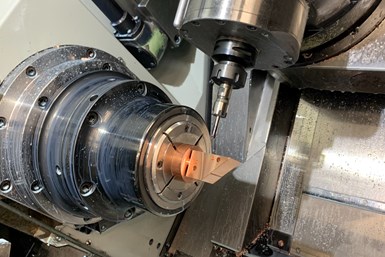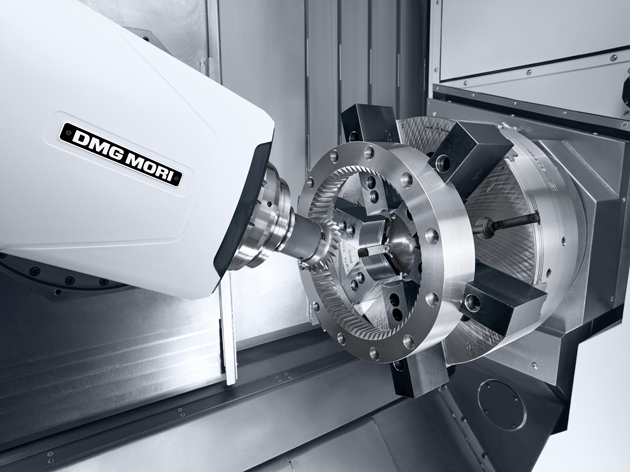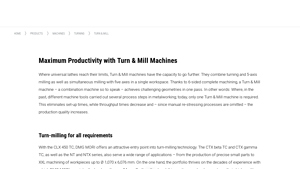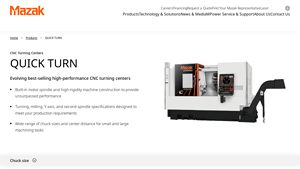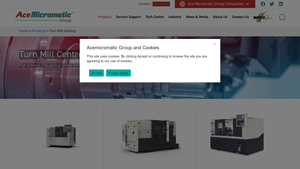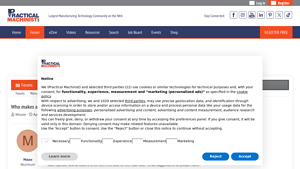Cnc Turn-Mill Guide: Type, Cost, Top List…
Introduction: Navigating the Global Market for cnc turn-mill
In today’s competitive landscape, sourcing CNC turn-mill machines poses a significant challenge for international B2B buyers seeking to optimize their manufacturing processes. These versatile machines, which blend turning and milling capabilities into a single setup, can dramatically enhance productivity and reduce operational costs. However, understanding the myriad options available, from various machine models to their diverse applications, is crucial for making informed purchasing decisions.
This comprehensive guide delves into the global market for CNC turn-mill machines, addressing key factors such as machine types, specific applications across industries, supplier vetting processes, and cost considerations. Each section is designed to equip buyers from regions like Africa, South America, the Middle East, and Europe—particularly Germany and Nigeria—with the knowledge necessary to navigate this complex landscape successfully. By providing actionable insights and expert advice, this guide empowers decision-makers to select the right CNC turn-mill machines that align with their production needs and strategic goals.
As you explore the intricacies of CNC turn-mill technology, you will gain a deeper understanding of how to leverage these advanced machines to achieve maximum efficiency, quality, and competitiveness in your operations. Whether you are an established manufacturer or a new entrant in the market, this guide serves as your essential resource for making well-informed investments in CNC turn-mill solutions.
Understanding cnc turn-mill Types and Variations
| Type Name | Key Distinguishing Features | Primary B2B Applications | Brief Pros & Cons for Buyers |
|---|---|---|---|
| CLX TC Series | Entry-level, compact design with automatic tool changer | Small to medium part production | Pros: Cost-effective, user-friendly. Cons: Limited capabilities for larger components. |
| CTX TC Series | Modular design, accommodates longer workpieces | Aerospace, automotive, and general engineering | Pros: Versatile, high precision. Cons: Higher initial investment. |
| NTX Series | High rigidity, compact footprint, advanced automation | Medical technology, high-precision components | Pros: Excellent for tight tolerances, space-saving. Cons: Complexity may require skilled operators. |
| NT Series | Box-in-box structure for optimal heat regulation | Heavy-duty machining, large components | Pros: Superior stability and precision. Cons: Larger footprint may require more floor space. |
| Hybrid Turn-Mill | Combines lathe and machining center functionalities | Custom part manufacturing, complex geometries | Pros: Highly flexible and efficient. Cons: May require significant capital investment and training. |
What Are the Key Characteristics of the CLX TC Series Turn-Mill Machines?
The CLX TC Series is designed as an entry point into turn-milling technology, making it ideal for businesses looking to optimize smaller production runs. Its compact design integrates an automatic tool changer, allowing for quick transitions between machining tasks. This series is particularly suitable for small to medium-sized parts across various industries. B2B buyers should consider the CLX TC for its cost-effectiveness and ease of operation, but note that its capabilities may be limited for larger components.
How Does the CTX TC Series Stand Out in the Market?
The CTX TC Series offers a modular design that caters to longer workpieces, making it a staple in industries like aerospace and automotive. This series is known for its precision and versatility, accommodating various machining processes. Businesses seeking high-quality output with the ability to handle complex geometries will find this series advantageous. However, potential buyers should weigh the higher initial investment against the long-term benefits of increased productivity and precision.
Why Choose the NTX Series for High-Precision Needs?
The NTX Series is engineered for high rigidity and precision, making it particularly suitable for sectors such as medical technology where tolerances are critical. Its compact footprint is ideal for operations with limited space, while advanced automation options enhance productivity. Buyers should consider the NTX Series for its capability to handle tight tolerances and complex parts, though the complexity may necessitate skilled operators for optimal performance.
What Advantages Does the NT Series Offer for Heavy-Duty Machining?
The NT Series is characterized by its box-in-box structure, which provides exceptional stability and precision, particularly for heavy-duty machining applications. This series can accommodate large workpieces, making it suitable for industries that require robust machining solutions. While it offers superior performance and durability, buyers should be aware of its larger footprint, which may require additional floor space in their facilities.
How Does Hybrid Turn-Mill Technology Enhance Custom Manufacturing?
Hybrid turn-mill machines integrate the functionalities of both lathes and machining centers, providing flexibility in manufacturing complex geometries. This technology is ideal for custom part production across various industries. Buyers should consider the efficiency and adaptability of hybrid turn-mill machines, though they may require a significant capital investment and training for operators to fully leverage their capabilities.
Key Industrial Applications of cnc turn-mill
| Industry/Sector | Specific Application of cnc turn-mill | Value/Benefit for the Business | Key Sourcing Considerations for this Application |
|---|---|---|---|
| Aerospace | Machining complex engine components | Enhanced precision and reduced cycle times | Certification standards, material compatibility |
| Automotive | Production of precision drivetrain parts | Improved efficiency and reduced setup costs | Flexibility for small and large batch production |
| Oil & Gas | Fabrication of valve and pump components | High durability and reliability in extreme conditions | Material sourcing for corrosion resistance |
| Medical Devices | Manufacturing surgical instruments | High precision and strict regulatory compliance | Quality certifications, precision tooling |
| Electronics | Production of intricate housings and enclosures | Streamlined production and reduced waste | Customization options, scalability for varied production volumes |
How is CNC Turn-Mill Used in Aerospace Applications?
In the aerospace industry, CNC turn-mill machines are crucial for machining complex engine components, such as turbine blades and housings. These components require high precision to ensure safety and performance. Turn-mill technology allows for multiple operations to be performed in a single setup, significantly reducing cycle times and improving the quality of the finished product. International buyers must consider the stringent certification standards and material compatibility, particularly for high-performance alloys used in aerospace applications.
What Role Does CNC Turn-Mill Play in Automotive Manufacturing?
CNC turn-mill machines are extensively used in the automotive sector for producing precision drivetrain parts, such as gears and shafts. The ability to perform turning and milling in one setup minimizes the need for multiple machines, thus enhancing efficiency and reducing setup costs. For B2B buyers, flexibility in handling both small and large batch productions is essential, alongside the capability to adapt to various materials and designs as automotive technologies evolve.
How Does CNC Turn-Mill Benefit the Oil & Gas Sector?
In the oil and gas industry, CNC turn-mill machines are employed for fabricating critical valve and pump components. These parts must withstand extreme conditions, making durability and reliability paramount. Turn-mill technology aids in achieving the required tolerances while also expediting production timelines. Buyers in this sector should prioritize sourcing materials with corrosion resistance and consider the machine’s capability to handle heavy-duty applications.
Why is CNC Turn-Mill Essential in Medical Device Manufacturing?
CNC turn-mill machines are vital for the production of surgical instruments and implants in the medical device industry. The precision required for these instruments is critical for patient safety and efficacy. Turn-mill technology facilitates the creation of complex geometries that are often required in medical applications. Buyers must ensure that their suppliers meet quality certifications and can provide precision tooling to maintain compliance with regulatory standards.
How is CNC Turn-Mill Used in Electronics Manufacturing?
In the electronics industry, CNC turn-mill machines are utilized to produce intricate housings and enclosures for various electronic devices. The streamlined production process reduces waste and enhances overall efficiency. For international B2B buyers, customization options and scalability are crucial, allowing them to adapt to varying production volumes while maintaining high-quality standards in a competitive market.
3 Common User Pain Points for ‘cnc turn-mill’ & Their Solutions
Scenario 1: Struggling with Setup Times and Production Efficiency
The Problem: Many B2B buyers in the CNC machining industry face significant challenges with long setup times when using traditional machining methods. For instance, a manufacturer producing complex components may require multiple machines to complete various operations like turning, milling, and drilling. This results in extended downtime between setups, leading to lost production hours and increased operational costs. The inability to efficiently manage the workflow can frustrate procurement managers who are under pressure to meet tight deadlines while maintaining quality.
The Solution: Investing in a CNC turn-mill machine can dramatically reduce setup times and enhance production efficiency. These machines allow for complete machining of parts in a single setup, combining turning and milling processes. To maximize the benefits, buyers should focus on selecting models with integrated automation features, such as automatic tool changers and sub-spindles. When sourcing a CNC turn-mill, consider models like the DMG MORI CLX 450 TC, which offers high versatility for small to medium-sized parts. Implementing proper training for operators on the machine’s capabilities can further streamline operations, allowing teams to leverage the full potential of the technology and significantly improve throughput.
Scenario 2: Difficulty in Achieving Complex Geometries
The Problem: Achieving intricate geometries is a common challenge for manufacturers, particularly in sectors like aerospace and medical device manufacturing, where precision is paramount. Buyers often find that conventional machining methods require multiple operations and setups to create complex shapes, increasing the likelihood of errors and rework. This not only affects product quality but can also lead to financial losses due to scrap parts and extended production timelines.
The Solution: A CNC turn-mill machine excels in producing complex geometries with high precision due to its ability to perform multiple machining operations in one setup. For buyers looking to tackle this issue, it’s essential to specify machines that offer advanced features such as 5-axis simultaneous machining. These capabilities allow for intricate detailing and contouring that would be impossible or highly inefficient with traditional methods. Buyers should also invest in CAM (Computer-Aided Manufacturing) software that integrates seamlessly with the turn-mill technology to optimize tool paths and reduce machining time. Working closely with suppliers to understand the software options available can help in selecting the right combination of machine and software that meets specific manufacturing needs.
Scenario 3: High Operational Costs and Resource Management Issues
The Problem: For many B2B buyers, managing operational costs while maintaining high production standards is a continual struggle. This is particularly true in regions with fluctuating labor costs or supply chain disruptions. Manufacturers often face the dilemma of needing to invest in multiple machines to meet diverse production demands, which can escalate operational costs and complicate resource management.
The Solution: Transitioning to a CNC turn-mill machine can significantly optimize resource management and reduce operational costs. By consolidating multiple machining processes into one machine, businesses can minimize the number of machines required, thus lowering maintenance, energy, and labor costs associated with operating multiple setups. Buyers should focus on models that provide versatility across various applications, such as the NTX series, which can handle both small precision parts and larger components. Additionally, exploring automation options, like robotic loading systems, can further enhance efficiency and reduce labor dependency. Conducting a cost-benefit analysis before investing can provide insights into long-term savings, helping to justify the initial capital expenditure and positioning the company for improved profitability.
Strategic Material Selection Guide for cnc turn-mill
What Are the Key Properties of Aluminum for CNC Turn-Mill Applications?
Aluminum is a widely used material in CNC turn-mill operations due to its excellent machinability and lightweight properties. It has a low density, making it ideal for applications where weight reduction is critical, such as in the aerospace and automotive industries. Key properties include a temperature rating of around 660°C before melting and good corrosion resistance, particularly when anodized.
Pros and Cons of Using Aluminum
The primary advantage of aluminum is its ease of machining, which allows for faster production times and lower manufacturing costs. However, its lower strength compared to steel can be a limitation in high-stress applications. Additionally, while aluminum is generally cost-effective, specialty alloys can be more expensive.
Impact on Application
Aluminum is compatible with various media, including water and oil, making it suitable for hydraulic components. However, its lower strength limits its use in heavy-duty applications.
Considerations for International Buyers
For buyers in regions like Europe and Africa, compliance with standards such as ASTM and DIN is crucial. Aluminum alloys often have specific designations (e.g., 6061, 7075) that need to be understood for proper application.
How Does Stainless Steel Perform in CNC Turn-Mill Operations?
Stainless steel is another popular choice for CNC turn-mill machining, known for its high corrosion resistance and durability. It can withstand temperatures up to 1,600°C, depending on the grade, making it suitable for high-temperature applications.
Pros and Cons of Using Stainless Steel
The key advantage of stainless steel is its strength and resistance to corrosion, making it ideal for applications in the chemical and food industries. However, it is more challenging to machine than aluminum, which can lead to higher manufacturing costs and longer production times.
Impact on Application
Stainless steel is compatible with a wide range of media, including acids and bases, making it suitable for various industrial applications. Its durability ensures longevity in demanding environments.
Considerations for International Buyers
Buyers should be aware of the different grades of stainless steel (e.g., 304, 316) and their specific properties. Compliance with international standards like ASTM and JIS is essential, especially for industries requiring stringent quality checks.
What Are the Advantages of Using Titanium in CNC Turn-Mill Processes?
Titanium is increasingly being adopted in CNC turn-mill applications due to its exceptional strength-to-weight ratio and corrosion resistance. It can withstand temperatures up to 1,668°C, making it suitable for high-performance applications, particularly in aerospace and medical devices.
Pros and Cons of Using Titanium
The primary advantage of titanium is its strength and lightweight nature, which is crucial in aerospace applications. However, it is one of the more expensive materials and can be challenging to machine, requiring specialized tools and techniques.
Impact on Application
Titanium is compatible with a variety of media, including saline solutions, making it ideal for medical implants. Its biocompatibility is a significant advantage in healthcare applications.
Considerations for International Buyers
International buyers should be aware of the high costs associated with titanium and the need for specialized machining capabilities. Compliance with industry standards is critical, especially in the medical field.
What Role Does Carbon Steel Play in CNC Turn-Mill Applications?
Carbon steel is commonly used for CNC turn-mill operations due to its balance of strength and machinability. It can withstand temperatures up to 1,370°C, depending on the carbon content, making it suitable for various applications.
Pros and Cons of Using Carbon Steel
The key advantage of carbon steel is its high strength and durability, making it suitable for heavy-duty applications. However, it is more prone to corrosion than stainless steel, which can limit its use in certain environments.
Impact on Application
Carbon steel is compatible with various media, including oils and fuels, making it suitable for automotive and industrial applications. Its strength ensures reliability in demanding conditions.
Considerations for International Buyers
Buyers should consider the carbon content and its implications for performance. Compliance with standards like ASTM is essential, particularly for applications in regulated industries.
Summary Table of Material Selection for CNC Turn-Mill
| Material | Typical Use Case for cnc turn-mill | Key Advantage | Key Disadvantage/Limitation | Relative Cost (Low/Med/High) |
|---|---|---|---|---|
| Aluminum | Aerospace components | Excellent machinability | Lower strength compared to steel | Medium |
| Stainless Steel | Food processing equipment | High corrosion resistance | More challenging to machine | High |
| Titanium | Medical implants | Exceptional strength-to-weight ratio | High cost and machining difficulty | High |
| Carbon Steel | Automotive parts | High strength and durability | Prone to corrosion | Medium |
This strategic material selection guide serves as a valuable resource for B2B buyers in understanding the properties, advantages, and limitations of various materials used in CNC turn-mill applications.
In-depth Look: Manufacturing Processes and Quality Assurance for cnc turn-mill
What Are the Main Stages of the CNC Turn-Mill Manufacturing Process?
The CNC turn-mill manufacturing process is characterized by a series of well-defined stages that ensure precision and efficiency in producing complex components. The primary stages include material preparation, forming, assembly, and finishing.
How Is Material Prepared for CNC Turn-Mill Machining?
Material preparation is the first critical step. This involves selecting high-quality raw materials, typically metals such as aluminum, steel, or titanium, which are known for their machinability and strength. The materials are then cut into manageable sizes using saws or shears, ensuring they fit the specifications for the CNC turn-mill machine. In some cases, materials may undergo heat treatment to enhance their properties before machining begins.
What Forming Techniques Are Employed in CNC Turn-Mill Operations?
The forming stage leverages the unique capabilities of CNC turn-mill machines, which integrate both turning and milling operations. This combination allows for complex geometries to be achieved in a single setup, significantly reducing cycle times. Key techniques include:
- Turning: The workpiece is rotated while a stationary cutting tool removes material to create cylindrical shapes.
- Milling: Rotary cutters are employed to remove material from the workpiece, enabling the creation of intricate features such as pockets, slots, and contours.
- Cross-Drilling: This technique enables holes to be drilled at various angles, adding versatility to the machining process.
By utilizing simultaneous 5-axis machining, manufacturers can achieve six-sided complete machining, which eliminates the need for multiple setups and enhances production efficiency.
How Is Assembly Handled in the CNC Turn-Mill Process?
In many cases, assembly may not be a significant stage in CNC turn-mill operations, as these machines often produce single components. However, for complex parts requiring multiple components, assembly is carefully planned and executed. This includes ensuring that all parts fit together precisely, often verified through precision measuring tools.
What Finishing Techniques Are Commonly Used After CNC Turn-Mill Machining?
The finishing stage is crucial for achieving the desired surface quality and tolerances. Techniques commonly used include:
- Deburring: Removing sharp edges and burrs left from machining to prevent injury and ensure proper fit.
- Polishing: Enhancing the surface finish for aesthetic or functional purposes, often necessary in industries like aerospace and medical.
- Coating: Applying protective coatings to enhance corrosion resistance or improve surface hardness.
What Quality Assurance Measures Are Relevant for CNC Turn-Mill Manufacturing?
Quality assurance is integral to the CNC turn-mill manufacturing process, ensuring that components meet international and industry-specific standards.
Which International Standards Should B2B Buyers Consider for CNC Turn-Mill Components?
B2B buyers should be familiar with several international quality standards that govern manufacturing processes. The most relevant include:
- ISO 9001: This standard focuses on ensuring quality management systems are in place, promoting consistency and continuous improvement.
- CE Marking: Particularly important for products sold within the European Economic Area, it indicates compliance with health, safety, and environmental protection standards.
- API Standards: For components used in the oil and gas industry, compliance with American Petroleum Institute (API) standards is essential.
How Are Quality Control Checkpoints Integrated into the CNC Turn-Mill Process?
Quality control checkpoints are strategically integrated throughout the CNC turn-mill process to monitor and ensure product quality. Key checkpoints include:
- Incoming Quality Control (IQC): Raw materials are inspected upon arrival for conformity to specifications.
- In-Process Quality Control (IPQC): Continuous monitoring during machining operations ensures that any deviations from quality standards are identified and rectified immediately.
- Final Quality Control (FQC): Completed parts undergo rigorous testing to verify they meet all design specifications before shipping.
What Common Testing Methods Are Used in Quality Assurance for CNC Turn-Mill Components?
Common testing methods utilized in the quality assurance process include:
- Dimensional Inspection: Using calipers, micrometers, and coordinate measuring machines (CMM) to ensure dimensions fall within specified tolerances.
- Non-Destructive Testing (NDT): Techniques such as ultrasonic testing or magnetic particle inspection are employed to detect internal flaws without damaging the components.
- Functional Testing: Verifying that the components perform as intended in their intended applications.
How Can B2B Buyers Verify Supplier Quality Control?
For international B2B buyers, verifying a supplier’s quality control processes is crucial. Here are some actionable strategies:
- Conduct Audits: Regular audits of the supplier’s facilities can provide insights into their quality management systems and adherence to standards.
- Request Quality Reports: Buyers should ask suppliers for detailed quality reports that outline their QC processes and any certifications they hold.
- Engage Third-Party Inspectors: Utilizing independent third-party inspection services can provide an unbiased assessment of product quality and compliance with standards.
What Nuances Should International Buyers Be Aware of Regarding QC Certifications?
When dealing with suppliers from diverse regions, international buyers must consider the following nuances in quality certification:
- Regional Standards: Quality standards may vary significantly across regions. For example, while ISO 9001 is widely recognized, specific industries may have additional local standards that must be adhered to.
- Cultural Differences: Understanding the cultural context in which a supplier operates can impact communication and expectations regarding quality assurance processes.
- Documentation Practices: Variations in documentation practices can affect the traceability of quality control measures. Buyers should ensure that suppliers maintain thorough records to facilitate transparency.
By comprehensively understanding the manufacturing processes and quality assurance measures associated with CNC turn-mill operations, international B2B buyers can make informed decisions, ensuring that they source high-quality components that meet their specific requirements.
Practical Sourcing Guide: A Step-by-Step Checklist for ‘cnc turn-mill’
In today’s competitive manufacturing landscape, sourcing the right CNC turn-mill machine is crucial for optimizing production efficiency and maintaining high-quality standards. This guide aims to provide a clear and actionable checklist for B2B buyers, particularly from diverse regions such as Africa, South America, the Middle East, and Europe, to navigate the procurement process effectively.
Step 1: Define Your Technical Specifications
Establishing clear technical specifications is the foundation of your sourcing process. Consider the types of materials you will be machining, the size and complexity of the parts, and the required precision levels. This clarity will help you identify machines that meet your unique production needs and prevent costly mismatches later on.
- Key considerations:
- Workpiece dimensions (length, diameter).
- Required tolerances and surface finishes.
- Desired operational capabilities (e.g., simultaneous 5-axis milling).
Step 2: Research Available Models and Technologies
Familiarize yourself with the various CNC turn-mill models available in the market. Different machines offer varying capabilities, such as high-speed milling, turning, or enhanced automation features. Understanding these technologies will allow you to select a machine that aligns with your production strategy.
- Explore options:
- Entry-level models for smaller operations.
- Advanced machines with integrated automation for larger-scale production.
Step 3: Evaluate Potential Suppliers
Thoroughly vet potential suppliers before making a commitment. Request detailed company profiles, case studies, and references from existing clients within your industry or region. This due diligence ensures that you partner with a reliable supplier who can deliver quality machines and support.
- What to look for:
- Supplier reputation and industry experience.
- Customer testimonials and case studies demonstrating successful implementations.
Step 4: Check for Compliance and Certifications
Ensure that the machines and suppliers comply with relevant industry standards and certifications. This is especially important when sourcing from different regions, as compliance can vary significantly. Certifications not only assure quality but also indicate adherence to safety and operational standards.
- Important certifications include:
- ISO 9001 for quality management.
- CE marking for compliance with European health, safety, and environmental protection standards.
Step 5: Request Detailed Quotes and Compare Costs
Once you have shortlisted potential suppliers, request detailed quotes that outline pricing, delivery times, warranty terms, and after-sales support. Comparing these factors will help you make an informed decision based on total cost of ownership rather than just upfront costs.
- Considerations for comparison:
- Payment terms and financing options.
- Cost of additional features or accessories.
Step 6: Assess After-Sales Support and Maintenance Services
After-sales support is crucial for the long-term success of your investment. Inquire about maintenance services, availability of spare parts, and technical support. A supplier with robust after-sales service can significantly reduce downtime and enhance machine longevity.
- Key questions to ask:
- What maintenance packages are available?
- Is there 24/7 technical support?
Step 7: Negotiate Terms and Finalize the Purchase
Before finalizing your purchase, ensure all terms are clearly laid out and agreed upon. This includes delivery schedules, installation services, and training for your staff. Effective negotiation can lead to better terms and added value for your organization.
- Essential negotiation points:
- Warranty extensions or additional training sessions.
- Discounts for bulk purchases or future orders.
By following this checklist, B2B buyers can navigate the complexities of sourcing CNC turn-mill machines with confidence, ensuring they make informed decisions that align with their production goals and operational needs.
Comprehensive Cost and Pricing Analysis for cnc turn-mill Sourcing
What Are the Key Cost Components in CNC Turn-Mill Manufacturing?
When sourcing CNC turn-mill machines, understanding the cost structure is critical for B2B buyers. The primary cost components include:
-
Materials: The cost of raw materials, including metal alloys and plastics, varies based on market demand and availability. High-quality materials may incur higher initial costs but can lead to better performance and durability, impacting the Total Cost of Ownership (TCO).
-
Labor: Skilled labor is essential for operating CNC turn-mill machines. Labor costs can vary significantly by region, with countries in Europe typically having higher wage standards compared to regions like Africa or South America. Additionally, training costs for operators should be factored in.
-
Manufacturing Overhead: This includes costs related to facility maintenance, utilities, and equipment depreciation. Efficient manufacturing processes can help mitigate these overhead costs.
-
Tooling: The investment in tools, fixtures, and dies necessary for CNC machining can add to the initial costs. High-quality tooling often results in better precision and longer life, leading to lower replacement costs over time.
-
Quality Control (QC): Implementing robust QC processes is vital in ensuring product standards. The costs associated with QC can vary based on the complexity of the parts being produced and the certifications required.
-
Logistics: Shipping costs, including customs duties and handling fees, play a significant role, especially for international buyers. Understanding the logistics landscape can help optimize costs.
-
Margin: Supplier margins can vary widely depending on their market positioning and the level of service they provide. Buyers should consider the value-added services that may justify a higher margin.
How Do Price Influencers Affect CNC Turn-Mill Costs?
Several factors can influence the pricing of CNC turn-mill machines:
-
Volume/MOQ: Purchasing in larger quantities often leads to lower per-unit costs. Suppliers may offer discounts for bulk orders, which is beneficial for larger manufacturers.
-
Specifications and Customization: Customized machines tailored to specific needs can significantly increase costs. It’s essential for buyers to balance the need for customization with budget constraints.
-
Materials: The choice of materials directly affects pricing. Premium materials can enhance performance but will increase initial costs. Buyers should evaluate the long-term benefits against upfront expenses.
-
Quality and Certifications: Machines that meet international quality standards or possess specific certifications may command higher prices. However, these certifications often lead to better reliability and performance.
-
Supplier Factors: The reputation and reliability of the supplier can influence pricing. Established suppliers may charge a premium for their proven quality and service, while newer entrants might offer lower prices to gain market share.
-
Incoterms: Understanding the agreed Incoterms can help buyers navigate additional costs related to shipping and insurance. Choosing the right Incoterm can impact the overall expenditure.
What Are the Best Negotiation Strategies for B2B Buyers in CNC Turn-Mill Sourcing?
B2B buyers should adopt strategic approaches to negotiate favorable terms when sourcing CNC turn-mill machines:
-
Cost-Efficiency: Focus on the TCO rather than just the upfront price. Highlighting long-term savings can justify a higher initial investment.
-
Leverage Volume: If possible, consolidate purchases to increase order volume and negotiate discounts.
-
Discuss Payment Terms: Flexible payment terms can ease cash flow, making it easier to manage the financial impact of large purchases.
-
Explore Supplier Relationships: Building strong relationships with suppliers can lead to better terms and priority service.
-
Research Market Rates: Understanding prevailing market rates can empower buyers in negotiations, enabling them to challenge inflated prices confidently.
What Pricing Nuances Should International Buyers Consider?
For international buyers, particularly those from Africa, South America, the Middle East, and Europe, several nuances can impact pricing:
-
Currency Fluctuations: Variations in exchange rates can affect overall costs. It’s advisable to negotiate prices in a stable currency.
-
Import Duties and Taxes: Understanding local regulations regarding import duties can prevent unexpected expenses.
-
Cultural Differences: Awareness of cultural negotiation styles can enhance communication and facilitate better deals.
-
Logistical Challenges: Be prepared for potential delays and additional costs associated with shipping and customs clearance.
Disclaimer on Indicative Prices
It is important to note that prices for CNC turn-mill machines can vary significantly based on numerous factors, including market conditions, supplier agreements, and specific machine configurations. Buyers should conduct thorough research and obtain multiple quotes to ensure a comprehensive understanding of potential costs.
Alternatives Analysis: Comparing cnc turn-mill With Other Solutions
Exploring Alternatives to CNC Turn-Mill Technology
In the competitive landscape of manufacturing, B2B buyers often seek efficient machining solutions that optimize productivity while minimizing costs. CNC turn-mill machines offer unique advantages by combining turning and milling operations, but exploring alternative technologies can provide valuable insights for making informed decisions. This analysis compares CNC turn-mill machines with two viable alternatives: traditional CNC lathes and multi-tasking machining centers.
Comparison Table
| Comparison Aspect | CNC Turn-Mill | Traditional CNC Lathe | Multi-Tasking Machining Center |
|---|---|---|---|
| Performance | High; capable of 6-sided machining | Moderate; limited to turning only | Very high; offers extensive capabilities |
| Cost | Higher initial investment | Lower initial cost | High initial investment, but versatile |
| Ease of Implementation | Requires skilled operators | Easier setup and operation | Complex setup; requires skilled technicians |
| Maintenance | Moderate; advanced technology | Generally low maintenance | High; requires regular calibration and skilled maintenance |
| Best Use Case | Complex geometries, small to large parts | Simple geometries, high volume | Complex parts requiring multiple operations |
Detailed Breakdown of Alternatives
Traditional CNC Lathe
Traditional CNC lathes focus on rotating workpieces for turning operations. They are generally more affordable and easier to implement, making them suitable for manufacturers with less complex machining needs. The primary advantage lies in their simplicity and lower maintenance requirements. However, they are limited in functionality, unable to perform milling or drilling tasks without additional machinery. This makes them less efficient for producing complex parts that require multiple machining processes.
Multi-Tasking Machining Center
Multi-tasking machining centers combine the capabilities of turning, milling, and drilling in one unit, similar to CNC turn-mill machines. They excel in high-precision applications and can handle complex parts efficiently. However, the initial investment is significantly high, and the machines require skilled technicians for setup and operation. Maintenance can also be challenging, as these machines have intricate systems that need regular calibration. While they are ideal for complex geometries and varied part sizes, the operational complexity may not be suitable for all manufacturers.
Conclusion: Choosing the Right Solution for Your Business Needs
When selecting the right machining solution, B2B buyers should assess their specific production requirements, budget constraints, and the complexity of the parts they intend to manufacture. CNC turn-mill machines are particularly beneficial for organizations focusing on high-quality, complex geometries, while traditional CNC lathes are suited for simpler, high-volume production. Multi-tasking machining centers offer versatility but come with higher costs and complexity. Understanding these alternatives will empower buyers to make decisions that align with their operational goals and market demands.
Essential Technical Properties and Trade Terminology for cnc turn-mill
What Are the Critical Technical Properties of CNC Turn-Mill Machines?
Understanding the technical specifications of CNC turn-mill machines is crucial for B2B buyers as these properties directly influence the performance, efficiency, and suitability of the machines for specific applications. Here are some key technical properties:
-
Machining Tolerance
– Definition: This refers to the allowable deviation from a specified dimension in a machined part. Typical tolerances for CNC turn-mill machines range from ±0.01 mm to ±0.1 mm.
– B2B Importance: High precision is essential in industries like aerospace and medical device manufacturing. A better tolerance can lead to reduced rework and scrap rates, thereby enhancing overall production efficiency. -
Spindle Speed
– Definition: Measured in revolutions per minute (RPM), spindle speed indicates how fast the spindle rotates during machining. Advanced CNC turn-mill machines can achieve spindle speeds of up to 20,000 RPM.
– B2B Importance: Higher spindle speeds allow for faster material removal rates, which can significantly reduce cycle times, leading to greater productivity and lower operational costs. -
Tool Capacity
– Definition: This refers to the number of tools that can be held and used by the machine, often ranging from 12 to 180 tools in modern machines.
– B2B Importance: A larger tool capacity enables quicker tool changes and reduces downtime, allowing for greater flexibility in production runs, especially in environments with varied part designs. -
Workpiece Size Capacity
– Definition: This property indicates the maximum dimensions of the workpiece that can be machined. For instance, some machines can handle workpieces up to 1,070 mm in diameter and 6,000 mm in length.
– B2B Importance: Knowing the workpiece size capacity is vital for buyers who deal with large components. It ensures that the machine can accommodate their manufacturing needs without requiring additional equipment. -
Automation Features
– Definition: Refers to the machine’s capability to integrate with automation systems, such as robotic arms or automated tool changers.
– B2B Importance: Automation enhances productivity by reducing manual labor and minimizing human error. This is particularly beneficial for high-volume production scenarios where consistency and speed are critical.
What Are the Common Trade Terms Used in CNC Turn-Mill Manufacturing?
Familiarity with industry terminology can facilitate smoother negotiations and transactions in the B2B landscape. Here are some essential terms:
-
OEM (Original Equipment Manufacturer)
– Definition: A company that produces parts or equipment that may be marketed by another manufacturer.
– Relevance: Understanding the role of OEMs is crucial for buyers who need reliable and high-quality components for their CNC machines. -
MOQ (Minimum Order Quantity)
– Definition: The smallest quantity of a product that a supplier is willing to sell.
– Relevance: Knowing the MOQ helps buyers manage inventory and cash flow. It is particularly important for businesses aiming to scale production while minimizing excess stock. -
RFQ (Request for Quotation)
– Definition: A document sent to suppliers to invite them to submit a price proposal for a specific quantity of goods or services.
– Relevance: An RFQ is essential for obtaining competitive pricing and ensuring that all potential suppliers are evaluated on the same criteria. -
Incoterms (International Commercial Terms)
– Definition: A set of internationally recognized rules that define the responsibilities of sellers and buyers for the delivery of goods under sales contracts.
– Relevance: Understanding Incoterms is vital for international transactions, helping to clarify shipping responsibilities, risk management, and cost allocation. -
Lead Time
– Definition: The amount of time it takes from placing an order to receiving the goods.
– Relevance: Buyers need to consider lead times to ensure timely project completion and maintain production schedules, particularly in industries with strict deadlines.
By comprehensively understanding these technical properties and trade terms, B2B buyers can make informed decisions that align with their operational goals and market demands.
Navigating Market Dynamics and Sourcing Trends in the cnc turn-mill Sector
What Are the Current Market Dynamics and Key Trends in the CNC Turn-Mill Sector?
The CNC turn-mill sector is experiencing robust growth driven by several global factors. As manufacturers seek to enhance productivity and reduce lead times, the demand for versatile machining solutions that integrate both turning and milling processes is on the rise. This trend is particularly pronounced in regions such as Africa, South America, the Middle East, and Europe, where industrial growth is accelerating. In these markets, businesses are increasingly investing in advanced technologies that support complete machining capabilities, enabling them to produce complex geometries in a single setup.
Emerging technologies such as Industry 4.0, which emphasizes automation and data exchange in manufacturing, are reshaping sourcing trends. International buyers are looking for CNC turn-mill machines equipped with smart features, such as predictive maintenance and real-time monitoring, to enhance operational efficiency. Automation solutions, including robotic arms and integrated loading systems, are also becoming essential, allowing for uninterrupted production cycles and reduced labor costs.
Additionally, sustainability is increasingly influencing sourcing decisions. Buyers are prioritizing suppliers who demonstrate a commitment to eco-friendly practices and materials, aligning with global sustainability goals. The shift towards digital platforms for sourcing and procurement is also notable, with online marketplaces facilitating easier access to a wide range of CNC turn-mill products and services.
How Important Is Sustainability and Ethical Sourcing in the CNC Turn-Mill Sector?
Sustainability and ethical sourcing are critical considerations for international B2B buyers in the CNC turn-mill sector. The environmental impact of manufacturing processes has come under scrutiny, prompting companies to seek solutions that minimize waste and energy consumption. CNC turn-mill machines, known for their efficiency in completing multiple processes in one pass, inherently reduce material wastage and energy use compared to traditional machining methods.
Furthermore, buyers are increasingly emphasizing the importance of ethical supply chains. This includes sourcing materials from suppliers that adhere to fair labor practices and environmental regulations. Certifications such as ISO 14001 for environmental management and ISO 45001 for occupational health and safety can serve as indicators of a supplier’s commitment to sustainability.
The integration of ‘green’ materials, such as recyclable alloys and biodegradable lubricants, is also gaining traction. By prioritizing sustainable practices, companies not only enhance their corporate responsibility but also appeal to a growing segment of environmentally-conscious consumers and partners. This alignment with sustainability principles can lead to enhanced brand reputation and customer loyalty in the competitive global market.
What Is the Evolution and Historical Context of CNC Turn-Mill Technology?
The evolution of CNC turn-mill technology can be traced back to the need for more efficient manufacturing processes. Initially, machining operations were divided between separate turning and milling machines, leading to increased setup times and operational inefficiencies. The introduction of CNC technology revolutionized this landscape, allowing for greater precision and automation in machining tasks.
As the demand for complex components grew, manufacturers began developing hybrid machines that combined the functionalities of lathes and milling centers. This led to the creation of turn-mill machines capable of performing multiple operations in a single setup, which significantly reduced production times and costs. Today, CNC turn-mill machines are equipped with advanced features such as 5-axis capabilities and real-time monitoring, making them indispensable in sectors ranging from aerospace to medical technology. The ongoing advancements in this field reflect a commitment to meeting the evolving needs of global manufacturers while promoting efficiency and sustainability.
Frequently Asked Questions (FAQs) for B2B Buyers of cnc turn-mill
-
How do I solve production bottlenecks when using CNC turn-mill machines?
To address production bottlenecks, consider implementing a comprehensive analysis of your workflow. Streamline processes by utilizing CNC turn-mill machines that allow for 6-sided complete machining, reducing setup times and increasing throughput. Investing in automation solutions, such as bar loaders or robotic systems, can also enhance productivity. Regularly maintain your machines and train your operators to ensure they maximize the capabilities of the equipment, which can significantly mitigate delays and improve overall efficiency. -
What is the best CNC turn-mill machine for small to medium-sized production runs?
For small to medium-sized production runs, the DMG MORI CLX 450 TC is an excellent entry point into turn-milling technology. It combines turning and milling capabilities in one compact machine, allowing for efficient 6-sided complete machining. This model features a B-axis and an automatic tool changer, which enhances flexibility and reduces setup times. Evaluate your specific machining requirements, such as part size and complexity, to select the most suitable model that balances performance and cost-effectiveness. -
How can I ensure quality assurance when sourcing CNC turn-mill machines internationally?
To ensure quality assurance, establish clear communication with potential suppliers regarding their manufacturing processes and quality control measures. Request certifications such as ISO 9001 to verify adherence to international standards. Additionally, consider conducting factory visits or third-party audits to inspect the machinery and production environment. Implementing a robust quality assurance plan that includes in-process measurements and testing can further ensure that the machines meet your specifications before shipment. -
What should I consider when negotiating payment terms for CNC turn-mill machines?
When negotiating payment terms, consider factors such as your cash flow and the supplier’s payment policies. Common options include upfront payments, deposits with balance upon delivery, or financing arrangements. Ensure that terms are clearly documented in the purchase agreement to prevent misunderstandings. Additionally, consider using secure payment methods that offer buyer protection, especially when dealing with international transactions to mitigate risks associated with currency fluctuations and potential disputes. -
What are the typical minimum order quantities (MOQ) for CNC turn-mill machines?
Minimum order quantities (MOQ) for CNC turn-mill machines can vary significantly between manufacturers and models. Generally, established manufacturers might have higher MOQs due to production efficiencies, while smaller suppliers may offer more flexible terms. Always inquire about the MOQ during the sourcing process and assess whether it aligns with your production needs. If your requirements are below the MOQ, consider negotiating for a trial purchase or exploring options for shared orders with other businesses. -
How can I vet potential suppliers of CNC turn-mill machines?
To effectively vet potential suppliers, conduct thorough research into their reputation within the industry. Check for customer reviews and testimonials, and request references from previous clients to gauge their satisfaction. Assess the supplier’s experience in exporting to your region, as this can indicate their familiarity with international trade regulations. Additionally, consider their after-sales support and warranty offerings, which are crucial for maintenance and troubleshooting after purchase. -
What logistics considerations should I keep in mind when importing CNC turn-mill machines?
When importing CNC turn-mill machines, logistics considerations include shipping methods, customs clearance, and delivery timelines. Choose a reliable freight forwarder experienced in handling heavy machinery to ensure safe transport. Familiarize yourself with import regulations and tariffs in your country to avoid unexpected costs. Additionally, plan for any necessary installation and training services upon arrival, as these can impact the timeline for getting your machines operational. -
Can CNC turn-mill machines be customized for specific applications?
Yes, CNC turn-mill machines can often be customized to suit specific applications. Many manufacturers offer a range of options, including specialized tooling, software features, and automation solutions tailored to particular machining requirements. When discussing customization, clearly outline your production needs and desired capabilities. Collaborating closely with the manufacturer during the design phase can result in a machine optimized for your unique production processes, enhancing efficiency and output quality.
Important Disclaimer & Terms of Use
⚠️ Important Disclaimer
The information provided in this guide, including content regarding manufacturers, technical specifications, and market analysis, is for informational and educational purposes only. It does not constitute professional procurement advice, financial advice, or legal advice.
While we have made every effort to ensure the accuracy and timeliness of the information, we are not responsible for any errors, omissions, or outdated information. Market conditions, company details, and technical standards are subject to change.
B2B buyers must conduct their own independent and thorough due diligence before making any purchasing decisions. This includes contacting suppliers directly, verifying certifications, requesting samples, and seeking professional consultation. The risk of relying on any information in this guide is borne solely by the reader.
Top 9 Cnc Turn-Mill Manufacturers & Suppliers List
1. DMG MORI – Turn & Mill Machines
Domain: us.dmgmori.com
Registered: 2013 (12 years)
Introduction: Turn & Mill Machines by DMG MORI combine turning and 5-axis milling in a single workspace, enabling 6-sided complete machining. Key models include CLX 450 TC, CTX beta TC, CTX gamma TC, NTX series, and NT series, catering to various applications from small parts to large workpieces (up to Ø 1,070 mm and 6,076 mm in length). Features include:
– 300% more productivity through complete machining
– Up…
2. INDEX – Turn-Mill Centers
Domain: index-group.com
Registered: 2001 (24 years)
Introduction: Turn-mill centers from INDEX & TRAUB offer high-precision solutions tailored to customer needs. Key models include:
– INDEX G200.2: 65 mm spindle clearance, 165 mm chuck diameter, 660 mm turning length.
– INDEX G200.3 / INDEX G220: 76 mm spindle clearance, 230 mm chuck diameter, 207 Nm max torque, 900 mm turning length.
– INDEX G300 / INDEX G320: 102 mm spindle clearance, 250 mm chuck diameter, 1…
3. MMS Online – Turn/Mill Machines
Domain: mmsonline.com
Registered: 1997 (28 years)
Introduction: This company, MMS Online – Turn/Mill Machines, is a notable entity in the market. For specific product details, it is recommended to visit their website directly.
4. EMCO – Hyperturn CNC Turn-Mill Centers
Domain: emco-world.com
Registered: 2007 (18 years)
Introduction: EMCO Hyperturn: CNC turn-mill centers
– Hyperturn 200 Powermill:
– Swing diameter: 1050 mm
– Max. Turning diameter: 1000 mm
– Max. Spindle speed: 1800 rpm
– Max. power: 84 kW
– Hyperturn 100 Powermill:
– Swing over bed: 800 mm
– Max. turning diameter: 720 mm
– Max. spindle speed: 3500 / 2500 rpm
– Max. drive power: 33 / 53 kW
– Hyperturn 65 Powermill High Performance:
…
5. Ellison Technologies – DN Solutions Mill Turn Centers
Domain: ellisontechnologies.com
Registered: 2005 (20 years)
Introduction: Ellison Technologies offers DN Solutions mill turn centers designed to streamline manufacturing processes by combining multiple operations into a single setup. Key features include multitasking capabilities (turning, milling, drilling, tapping), single setup efficiency (reducing setup times and errors), enhanced precision (higher accuracy and consistency), and increased productivity (streamlined w…
6. Mazak – QUICK TURN CNC Turning Centers
Domain: mazak.com
Registered: 1998 (27 years)
Introduction: CNC Turning Centers QUICK TURN series: Evolving best-selling high-performance CNC turning centers with built-in motor spindle and high-rigidity machine construction. Features include turning, milling, Y-axis, and second spindle specifications. Chuck sizes range from 6 inch to 21 inch. Key specifications:
– Built-in motor spindle for heavy-duty machining of difficult materials and high-speed machi…
7. Reddit – Mill-Turn CNC Machines
Domain: reddit.com
Registered: 2005 (20 years)
Introduction: Mill-Turns are advanced CNC machines that combine lathe and milling capabilities, featuring a swivel milling head and a powerful motor. They are significantly more expensive than traditional lathes, with prices around CAD 600,000. Users appreciate their ability to machine complete parts in one setup, utilizing dual spindles and a milling head or live tools. Mill-Turns offer advantages in rigidity,…
8. Acemicromatic – High Precision Turn Mill Centres
Domain: acemicromatic.net
Registered: 2006 (19 years)
Introduction: Turn Mill Centres – High precision CNC turning centers with C-axis capability and live tools for various machining needs. Key models include: CTM 06 LM M (combines turning and milling), LT-2 LM MSY (Horizontal TurnMill Centre with Sub Spindle and Y-Axis), LT-2 LM 500 MY (Horizontal TurnMill Center with Y-Axis), LT-2 LM 500 MSY (Horizontal TurnMill Center with Sub Spindle and Y-Axis), LT-2 XL / LM …
9. Mill-Turn Machines – Essential Features for Aluminum Parts
Domain: practicalmachinist.com
Registered: 2000 (25 years)
Introduction: The discussion revolves around purchasing mill-turn machines, specifically for aluminum parts. Key requirements include: 1. Two spindles capable of orienting the part between both sides. 2. At least a couple of feet between each spindle. 3. A minimum of a three-inch thru tube on the main side. Suggested brands include: 1. Mori Seiki (noted for quality but concerns about recent quality decline post…
Strategic Sourcing Conclusion and Outlook for cnc turn-mill
As international markets evolve, the strategic sourcing of CNC turn-mill machines presents a unique opportunity for businesses across Africa, South America, the Middle East, and Europe. The integration of turning and milling processes into a single machine not only enhances productivity by reducing setup times but also significantly improves machining quality. With advanced models available, such as the DMG MORI series, companies can achieve 6-sided complete machining, accommodating a diverse range of part sizes and complexities.
Investing in CNC turn-mill technology allows manufacturers to streamline their operations, reduce capital expenditures on multiple machines, and enhance their competitive edge in a global marketplace. The ability to automate processes further amplifies these advantages, making it essential for businesses to consider automation solutions as part of their sourcing strategy.
Looking ahead, B2B buyers are encouraged to prioritize strategic partnerships with reputable suppliers who offer innovative turn-mill solutions tailored to their specific needs. By embracing these technologies, organizations can not only meet current manufacturing demands but also position themselves for future growth and success in an increasingly competitive landscape. Engage now with suppliers to explore how CNC turn-mill machines can transform your operations and drive profitability.
